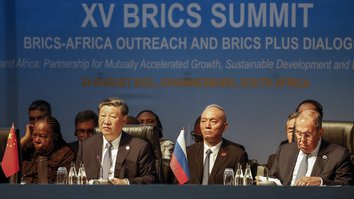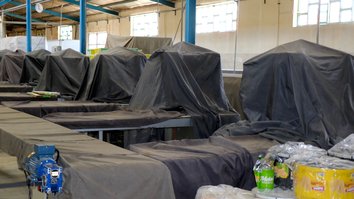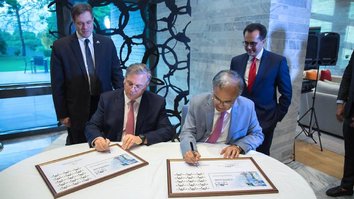The "Islamic State of Iraq and Syria" (ISIS) admitted last week that its leader Abu Hasan al-Hashimi al-Qurashi had been "killed in battle" and announced a replacement to head up its remaining sleeper cells.
But local sources said the top ISIS leader had in fact blown himself up under siege -- following in the footsteps of his short-lived predecessors.
Al-Hashimi, an Iraqi, was killed "in combat with enemies of God", ISIS said in an audio message on November 30, without specifying the date or circumstances of his death.
According to the Syrian Observatory for Human Rights, however, al-Hashimi was killed in the Daraa province town of Jassim in southern Syria on October 14, during security operations carried out by local factions.
After he was besieged by local factions, the Observatory said, the ISIS commander blew himself up inside a house where he was sheltered with his family. None of his family members were killed, it said.
Separately, local factions blew up a nearby house where two ISIS commanders were sheltering, the Observatory said, killing them both. One was Lebanese and the other Syrian, it said.
Daraa activist Rachid al-Hourani told Al-Araby al-Jadid Thursday that al-Qurashi was known to locals as Abu Abd al-Rahman al-Iraqi and that he married a woman from Daraa about a year ago.
Al-Hourani said the former ISIS leader had established a "court" in Jassim, a move that exposed the presence of the group's members in the city.
Al-Qurashi was killed in clashes with opposition factions on October 17, according to al-Hourani.
ISIS cells have recently ramped up their attacks targeting former leaders and members of Syrian opposition factions to further consolidate their presence in the city of Jassim, media activist Mohammed al-Daraawi told Al-Araby al-Jadid.
In its audio message announcing the top ISIS leader's death, the group said Abu al-Hussein al-Husseini al-Qurashi has been named as its fourth leader.
Belonging to the Quraysh tribe -- the tribe of the Prophet Mohammad -- is seen as a prerequisite for becoming the leader of ISIS.
The message did not provide details on the new leader but said he was a "veteran" and called on all groups loyal to ISIS to pledge their allegiance to him.
'Another blow to ISIS'
In a statement, US Central Command (CENTCOM) said al-Hashimi was killed in an operation carried out by Syrian opposition fighters of the Free Syrian Army (FSA) in Daraa province in mid-October.
The death of Abu Hasan al-Hashimi al-Qurashi in mid-October "is another blow to ISIS", CENTCOM spokesman Col. Joe Buccino said.
He cautioned that "ISIS remains a threat to the region", however, stressing that US and partner forces "remain focused on the enduring defeat of ISIS".
On Wednesday, US-backed Kurdish forces in Deir Ezzor dismantled a 10-member ISIS cell and seized a large amount of weapons and ammunition in the possession of the cell members, the international coalition said.
In the northern Daraa town of Jassim, an improvised explosive device (IED) planted in an outdoor market on Thursday triggered panic, as local residents feared ISIS retaliation for al-Hashimi's death, the Observatory said.
A team of explosives specialists from local factions dismantled the IED, the Observatory said, after evacuating the market and blocking its entrances.
Local authorities informed the residents, via mosques' loudspeakers, not to head to the market for security reasons and concerns about expected attacks by ISIS, the Observatory said.
Short-lived ISIS leaders
ISIS's previous chief, Abu Ibrahim al-Qurashi, blew himself up, along with members of his own family, in February this year during a US raid in northern Syria's Idlib province.
His predecessor Abu Bakr al-Baghdadi was killed, also in Idlib, in October 2019.
White House Press Secretary Karine Jean-Pierre said al-Hashimi's death "was not a result of any US action".
"We are pleased to see the removal of ISIS leaders in such quick succession," she said. "The United States remains committed to countering the global threat from ISIS and stands ready to work with international partners."
The ISIS leadership has suffered repeated blows this year.
In October, US forces killed a "senior" ISIS element in a pre-dawn raid in northeastern Syria, CENTCOM said at the time.
The raid targeted "Rakkan Wahid al-Shammari, an ISIS official known to facilitate the smuggling of weapons and fighters", CENTCOM said.
It said a later air strike had killed two other senior ISIS elements.
In July, the Pentagon said it had killed Syria's top ISIS leader in a drone strike in the north of the country.
CENTCOM said he had been "one of the top five" ISIS leaders.
In June, international coalition forces said they captured a senior ISIS bomb maker in an airborne operation carried out before dawn in northern Syria's Aleppo province.
The international coalition did not name the targeted ISIS operative, but US officials identified him as Hani Ahmed al-Kurdi, also known as the "Wali of al-Raqa", ISIS's de facto capital, The Washington Post reported.

![This picture taken March 24, 2019, shows a discarded ISIS flag lying on the ground in the village of al-Baghouz in Syria's Deir Ezzor province, a day after the declaration of the group's defeat by the international coalition backed Syrian Democratic Forces. [Guiseppe Cacace/AFP]](/cnmi_pf/images/2022/12/05/39288-Discarded-ISIS-flag-585_329.jpg)






